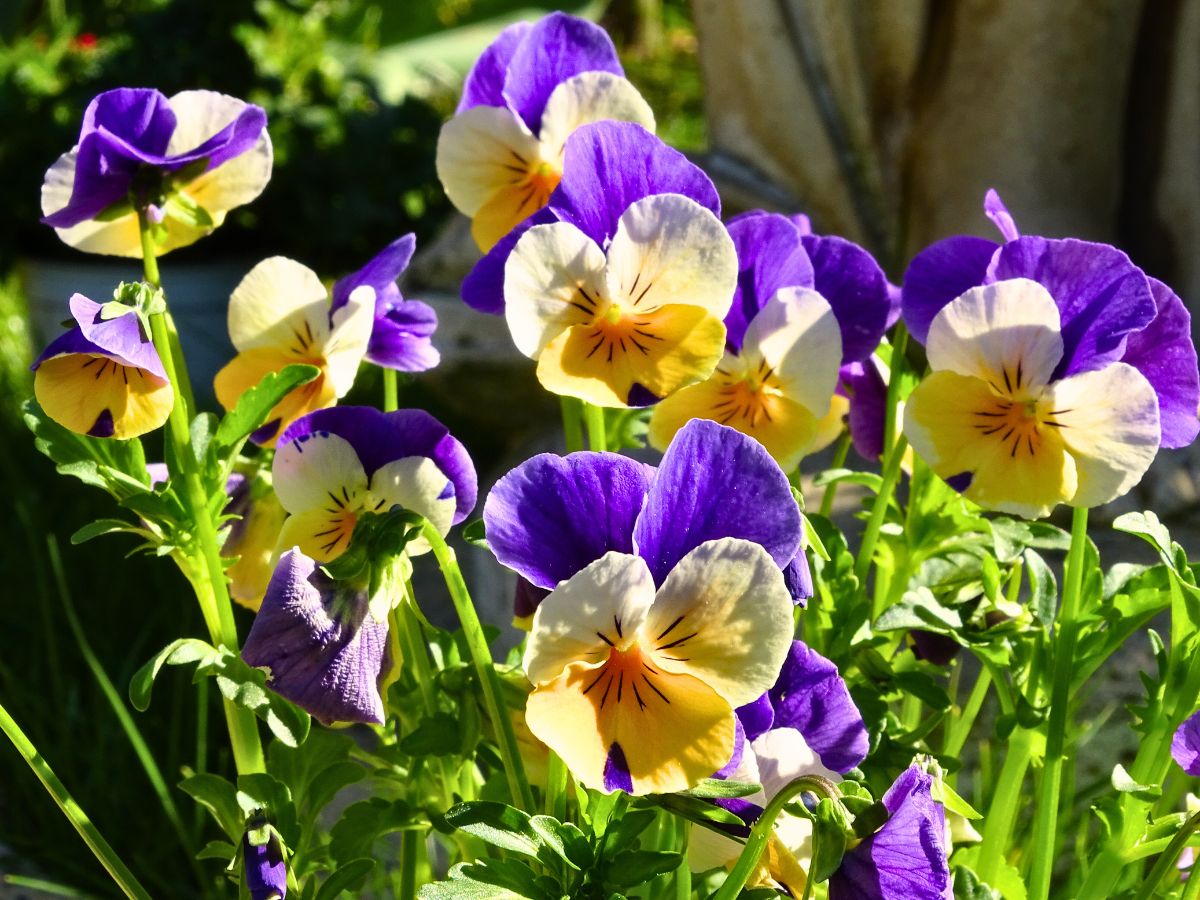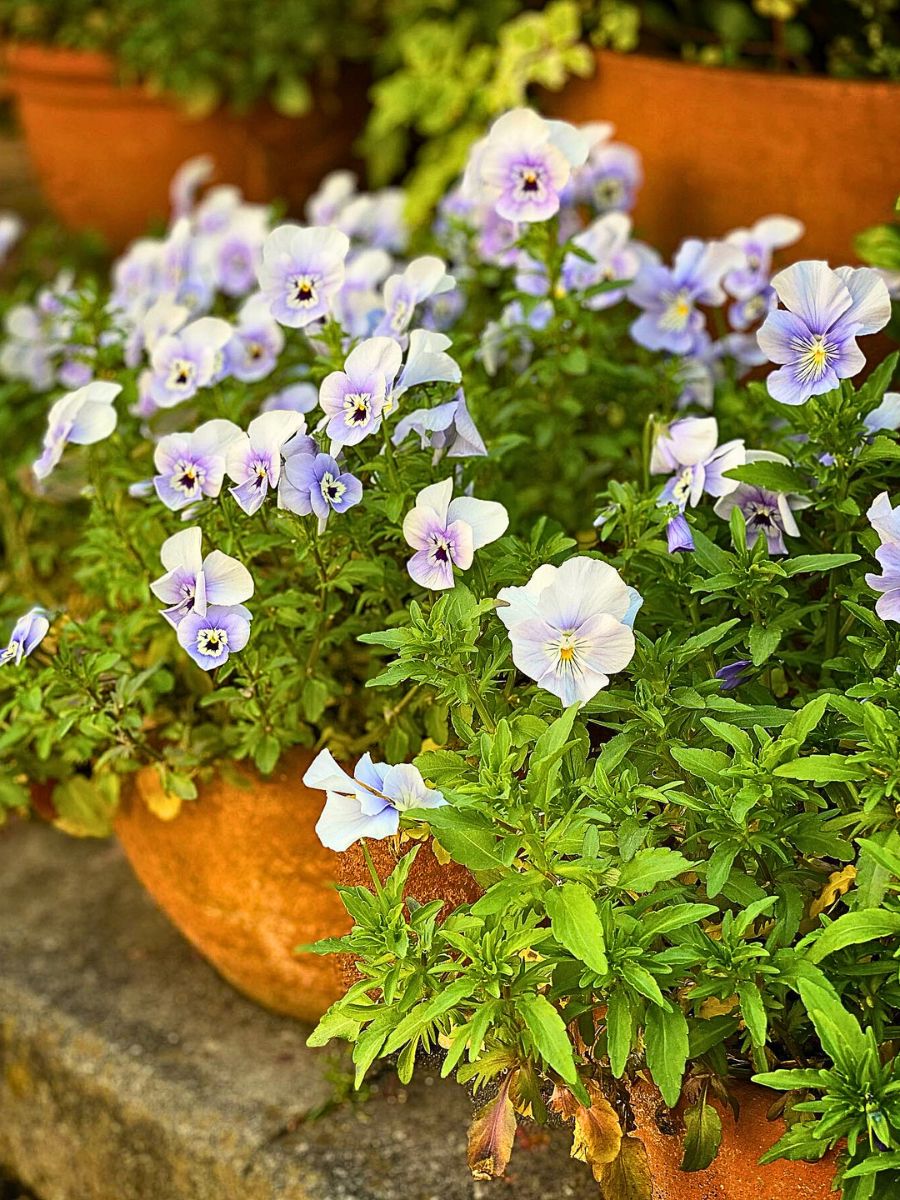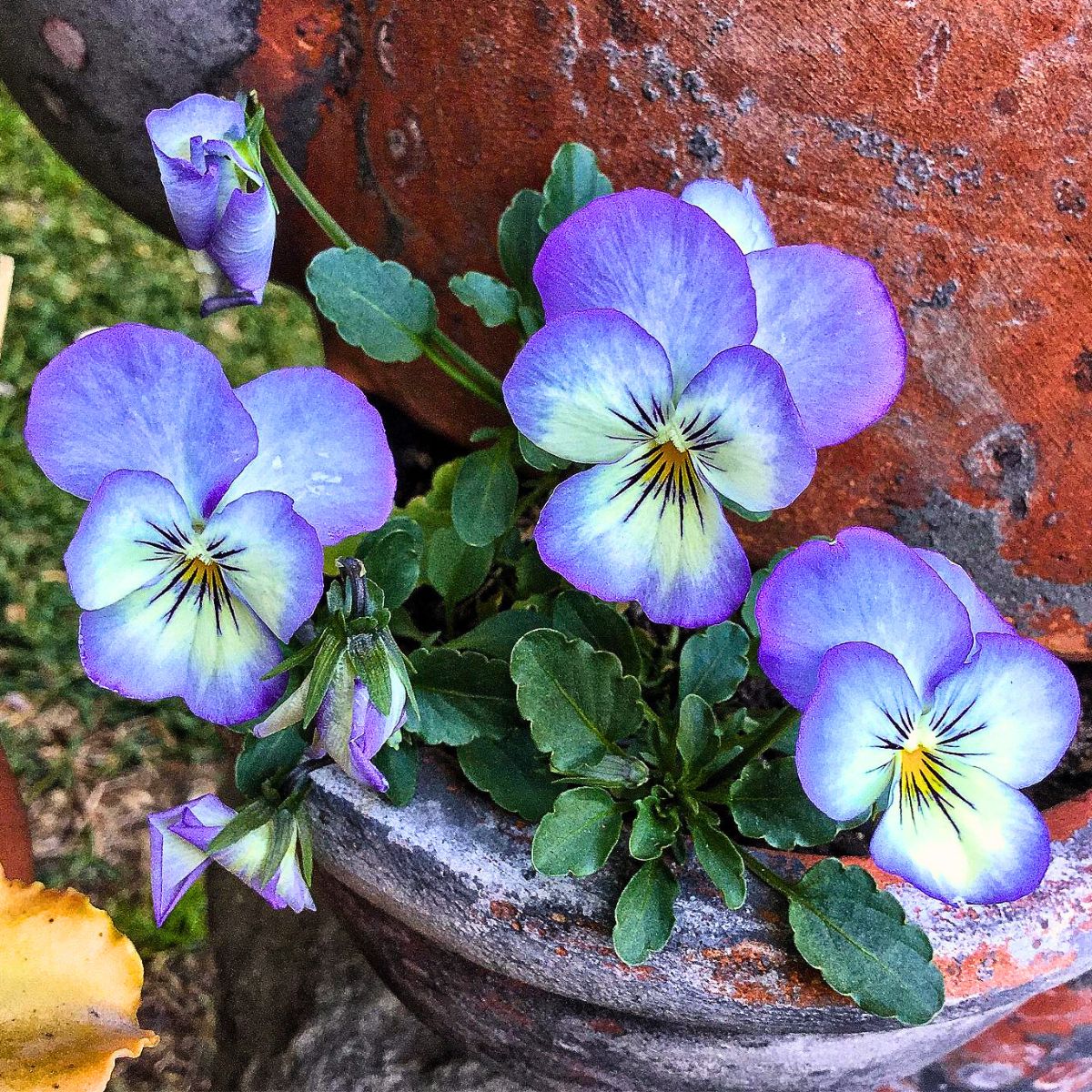The viola flower, a charming member of the Violaceae family, is more than just a pretty face. Also known as a violet, it boasts, delicate, vibrant blooms in a range of colors, making it a prized addition to gardens worldwide. What is more, its ease of cultivation, coupled with its rich symbolism and beauty, has made it quite a garden staple.
From creating stunning winter displays to inspiring artistic expression, this flower offers a multifaceted appeal. Whether one seeks to add a pop of color to their landscape, create a stunning winter display, or incorporate the viola's symbolic meaning into their life, this lovely and remarkable flower will surely delight.
What Is a Viola Flower?
Viola flowers, often celebrated for their delicate beauty and colors, are charming blooms belonging to the genus Viola. This genus encompasses a variety of species, including the well-known pansy. They are small, colorful flowers that typically appear in shades of purple, yellow, blue, and white.

Photo by zimt2003
They are part of the Violaceae family and include more than 500 species found primarily in temperate regions of the Northern Hemisphere. They generally have five petals, with the lower petal often featuring a spur or small pouch. Some species, like Viola odorata (sweet violet), are fragrant, while others are not. The most common types include the wild pansy (Viola tricolor), heartsease, and various cultivated varieties known for their ornamental appeal.
Violas typically flower from early spring through late fall, with some varieties blooming throughout the winter in milder climates. Their peak blooming period, however, is during cooler weather, making them ideal for early spring to late fall and winter displays. They, also, hold significant meanings and cultural symbolism across different cultures.

Viola Flower vs Pansy: What's the Difference?
While violas and pansies are often confused for each other, they are in actual sense distinct members of the Violaceae family. Both plants share similarities in their appearance and growing habits, but there are a few key differences to note. The most obvious distinction is the size of the flowers. Violas generally have smaller, more delicate blooms than their pansy counterparts. Viola flowers typically range from 1-2 inches in diameter, while pansy flowers can grow up to 4 inches wide.
Another difference lies in the growth habit of the plants. Violas tend to have a more compact, mounding growth pattern, often reaching just 6-12 inches in height. Pansies, on the other hand, can grow taller and more sprawling, with a height of 6-12 inches and a spread of 12-18 inches.

When it comes to bloom time, violas and pansies share some similarities. Both plants are known for their ability to flower in cool weather, with blooms that can last well into the winter months. However, violas are generally considered to have a longer flowering period, often starting earlier in the spring and continuing later into the fall. By and large, while violas and pansies may look quite alike, they are different plants with their own unique characteristics and growing requirements. Therefore, understanding the differences can help you choose the right flower for your garden and design.

The Symbolic Meaning of Viola Flowers
Throughout history, these flowers have been known to be steeped in rich allegorical symbolism and meaning. They are, in most cases, associated with innocence, humility, modesty, fidelity, remembrance, grief, faithfulness, and virtue, across different settings. In ancient cultures, they were associated with love and devotion - often linked to the Goddess Aphrodite in Greek mythology. In literature, violets have been depicted as symbols of romantic love and fidelity, later making them a popular choice for contemporary floral arrangements and tattoos as well.

In the Victorian era, a gift of viola flowers was a way to convey the message "I'll always be true to you." Plus, the viola's delicate, heart-shaped petals have also made it a symbol of young love and pure thoughts.
Modesty and Humility
One of the most prominent meanings attributed to viola flowers is that of modesty and humility. Their small, unassuming blossoms often grow in clusters, quietly gracing gardens and meadows without drawing excessive attention to themselves. This understated beauty has led to their association with the idea that true value lies in simplicity. Thus, in many cultures, violets symbolize the importance of humility in human character. They, in essence, demonstrate that greatness can be found in modest actions and quiet presence.

Love and Fidelity
Violas are also deeply connected to themes of love and fidelity. The ancient Greeks used violets in love potions, believing they could nurture loyalty and affection between lovers. This association continued through the ages, particularly during the Victorian era when flowers were used - in floriography - as a means of communication in romantic contexts. In this language of flowers, violets conveyed messages of devotion and steadfastness. They, therefore, became a popular choice for expressing feelings in a subtle yet expressive way.

Remembrance and Sorrow
Violets also hold significance when it comes to remembrance. Their ephemeral nature could be interpreted as a reminder of life's transitory moments. In literature and art, violets have been depicted as symbols of loss and mourning. For instance, in Shakespeare's works, violets are associated with Ophelia's sorrow over her father's death. A disheveled Ophelia hands out imaginary flowers to her brother, the King and Queen, and mad with grief over the loss of her father, she says her violets withered when her father died.
Here, the flower is associated with death and a young woman's grief over losing a loved one. The flowers symbolize both innocence lost and the lasting nature of love even after loss. This duality highlights how violets can arouse both joy and sadness, thus suitable for memorials or tributes.

Spiritual and Divine Connections
In various spiritual traditions, violets are linked to deeper metaphysical meanings. They are often associated with Venus, the goddess of love, which enhances their connection to romantic themes. Additionally, violets have been viewed as symbols of protection and spiritual insight. In some cultures, carrying violets is believed to ward off negative energies or malevolent spirits. The flower's gentle fragrance is, also, said to promote peace and tranquility, inviting introspection and connection to nature. In addition to these connotations, the viola holds other spiritual significance in different cultures. In some traditions, the viola is seen as a link to the divine, representing humility and devotion. The flower's ability to bloom even in the harshest of conditions has also made it a symbol of resilience and perseverance.

Cultural Significance of Violets
The significance of violets extends beyond personal symbolism; they have also played important roles in various historical and cultural contexts. In ancient Greece, violets were linked to Sapphic love due to poet Sappho's references to them in her work. This connection made these flowers a symbol within the LGBTQ+ community, representing the love between women.
Also, during the Victorian era, violets became a fashionable flower among the upper class. Queen Victoria herself was an avid admirer of these blooms, helping to popularize them further. Their popularity during this time led to what was known as "violet mania," where they were featured in virtually everything from fashion accessories to culinary delights.

Also, different colors of violets, carry specific meanings as well. Purple violets, for instance, often symbolize thoughts occupied with love. White violets are representations of innocence and purity, welcoming new beginnings. Blue ones, on the other hand, convey serenity and emotional balance.
Symbolic Meanings of Viola Flower Tattoos
Viola flower tattoos are an increasingly popular trend for their beauty and rich symbolism. These tattoos often capture the delicate essence of the viola flower, which is associated with various meanings that resonate with different individuals. Such a tattoo of a viola flower could be a reminder to remain grounded and humble, regardless of one's achievements or status. This quality makes it an appealing choice for those who value simplicity and authenticity in their lives.

Photo by @hoperosie
This viola flower tattoo can, also, represent deep emotional bonds between partners or a commitment to self-love. It could, likewise, be symbolic of innocence and purity. This symbolism is particularly significant for individuals who wish to commemorate new beginnings, a fresh start, or reflect on their untainted nature and inner purity. It could, also, be a tribute to loved ones lost, capturing feelings of love, loss, and the lingering nature of memory.
Viola flower tattoos can be designed in different styles, from minimalist single blooms to elaborate arrangements combined with other elements like quotes or symbols that enhance their significance. Popular placements include the wrist, ankle, or shoulder, where they can be easily showcased or discreetly concealed. Regardless, the viola flower tattoo allows individuals to express their values and emotions through a design that resonates personally and culturally.

Growing and Caring for Viola Flowers
One of the reasons the viola is such a favorite garden plant is its relative ease of care. Viola flowers thrive in a wide range of climates and soil types. They, therefore, are an accessible choice for both novice and experienced gardeners. When it comes to growing viola plants, the most important considerations are sunlight and soil. Violas prefer full sun to partial shade, thriving in areas that receive at least six hours of direct sunlight per day. They also do best in well-draining, nutrient-rich soil with a slightly acidic pH.

To grow violas from seed, start them indoors 6-8 weeks before your last expected frost date. Sow the seeds about 1/4-inch-deep and keep the soil consistently moist until germination, which typically occurs within 7-21 days. Once the seedlings have their first set of true leaves, you can transplant them into your garden. Alternatively, you can purchase viola plants from a local nursery or garden center and transplant them directly into your garden. Be sure to plant them at the same depth they were growing in their original container, spacing them about 6-12 inches apart.
Ongoing care for your viola plants is relatively simple. Water them regularly, about one inch per week, and deadhead spent blooms to encourage continuous flowering. You can also fertilize them every 4-6 weeks with a balanced, water-soluble fertilizer to support healthy growth.

Can Viola Flowers Thrive in Wintry Conditions?
Viola flowers can indeed thrive in winter conditions, which is one of the best qualities of these flowers. They can thrive in cooler temperatures. While many annual flowers struggle or die off in the winter, violets can continue to bloom through the colder months, providing a welcoming splash of color in the garden even during winter.

Certain species, particularly Viola hiemalis (commonly referred to as winter pansies), are specifically bred to withstand colder temperatures and often bloom throughout the winter duration because they are capable of surviving frost, freezing temperatures, cold, and even snow, while still blooming. So you can be sure that they provide some color during the gray winter months.

Photo by @r.i.e_1211
They are, also, available in various shades including purple, yellow, and white, which brighten up winter gardens. These flowers, likewise, tend to produce more flowers than larger-flowered pansies, thus an excellent choice for winter displays.
Growing Violas in the Winter Garden
While most annual flowers fade and die off as the temperature drops, violas can withstand cold weather and continue to bloom well into the winter, as a result, they are a fantastic choice for cold-weather gardening. Basically, they are one of the first flowers to emerge in the spring and one of the last to fade in the fall, giving gardeners several months of enjoyment from a single planting. In mild climates, they may even bloom all year round!

To get the most out of your viola plants in the winter, be sure to choose a sunlit spot in the garden that is protected from harsh winds. You can also enhance the viola flowers' cold-weather performance by planting them in raised beds or containers, which will help insulate their roots.
When the temperatures start to drop, you can provide an extra layer of protection for the violas by covering them with a frost blanket or row cover. This will help trap warm air around the plants and prevent damage from freezing temperatures and snow. This way, they continue to thrive and bloom throughout the winter, guaranteeing a touch of whimsy and color in the cold-weather garden.

Also, regularly remove faded flowers to promote new blooms. This simple practice can significantly extend the flowering period of the violas. And in colder climates, apply a layer of mulch around the base of the plants. This insulates the roots and helps retain moisture while protecting against frost damage.

Photo by @thegardenpantry_
Enjoying Viola Flowers
Violas can be incorporated into everyday life in different creative ways. Be it in the home decor, or garden, or incorporating the flower's symbolic meaning into a personal project. They offer endless possibilities. One popular way to enjoy violas is through dried or pressed flowers. These gentle blooms can be used to create spectacular artworks, such as wall hangings, greeting cards, or even bookmarks. The pressed flowers can also be used to make natural, homemade potpourri or sachets, filling one's space with a subtle, natural fragrance.

For those with a creative flair, violas can also be a beautiful subject for drawing or painting. Their unique, heart-shaped petals and vibrant colors make them an appealing muse for artists of all skill levels. One can even incorporate viola flower drawings into handmade cards, journals, or other personalized projects. Whichever way, these charming flowers are sure to bring a touch of beauty, meaning, and personal expression to your world!
Feature image by @johannakekki, header image by matthiasboeckel.










